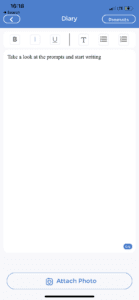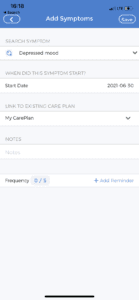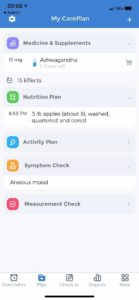
Do you need a place to write down your thoughts? Are there too many emotions running through your head? Would writing them down or speaking about them help? Then you have to try the feelings journal on the CareClinic app. Some people prefer talking and that’s okay too. Find a therapist that works for you. They too will recommend a feelings journal.
This article will take you through the science behind feelings. The article will first provide a brief understanding of how the lobes affect emotion and feeling. It will then define what each lobe primarily does. You will then be provided a step-by-step guide on how to get started on your feelings journal journey. Finally, the article will talk about why CareClinic is the best app to use, and how to use it.
[1][2]Table of Contents
- What Are Feelings?
- What Are Emotions?
- What is the Science Behind Feelings?
- Understanding Emotion Tracker
- How Do You Deal With Your Emotions & Feelings?
- What Is An Emotion Tracker?
- What Is A Feelings Journal?
- How Do I Start Using A Feelings Journal?
- How to Use CareClinic to Manage Your Feelings.
- Where Do I Find The CareClinic App?
- Moving Your Feelings Forward
What Are Feelings?
Feelings are defined as emotional states or reactions to certain situations or circumstances. They are produced by chemical reactions in the brain. Do not confuse feelings and emotions though. While emotions are associated with bodily reactions activated through neurotransmitters and hormones, feelings are the conscious experiences of emotions. To simplify this further, what people recognize as emotions are actually feeling. For example, smiling is the emotion, while happiness is the feeling. A big misconception is that feelings and emotions can be interchanged as terms. They cannot. Feelings are responses to emotions. Emotions are defined below.
[3][4]What Are Emotions?
According to the American Psychological Association (APA), emotion is defined as “a complex reaction pattern, involving experiential, behavioural and physiological elements.” Emotions are how a person deals with situations they find significant. Emotions have three major components. Number one having a subjective experience. Number two has a physiological noticeable response, and finally, it has a behavioural response. For example, losing a loved one is a subjective experience that causes tears to form which is physiological and finally causes you to cry to express sadness which is behavioural.
[5]What is the Science Behind Feelings?
Feelings originate in the neocortical region of the brain. The neocortical region comprises four regions: frontal, parietal, occipital and temporal lobes. Below is a brief summary of each lobe’s main functions:
- Frontal – The frontal lobe is part of the brain’s cerebral cortex. The paired lobes are known as the left and right frontal cortex. The frontal lobe works alongside other brain regions to control how the brain functions overall.
- Parietal – The parietal lobes are divided into two functional regions. One involves sensation and perception and the other involves vision.
- Occipital – The occipital lobe is the smallest lobe. It allows you to see and process stimuli from the outside world. Additionally, the occipital lobe assigns meaning to the visuals it sees.
- Temporal – The temporal lobe helps process sensory input. This means pain and auditory (sound) stimuli. It also helps you understand language, retain visual memories, and process and remember emotions. When you write in your feelings journal, you use the temporal lobe the most.
Feelings are shaped by personal experiences, beliefs, memories, and thoughts linked to that emotion. They are essential for your brain to identify the emotion. Once identified your brain assigns meaning to it to those emotions.
[6][7]Understanding Emotion Tracker
While emotions can be measured through experimentation, feelings are measured through self-reporting techniques. The three most common feelings techniques are, firstly surveys, secondly interviews and finally, questionnaires. These answers can create a baseline for psychologists, psychiatrists and other medical professionals to help you process your emotions. Emotions on the other hand, which cause feelings, can be measured through many scientific experiments:
- Eye tracker – measures pupil dilation
- Galvanic Skin Response (GSR) – measures electrical variations in the skin
- Electrocardiography (ECG) – measures heart rate and electrical activity
- Electroencephalogram (EEG) – measures the electrical activity of the brain
- Functional magnetic resonance (fMRI) – measures the activity of the brain by tracking blood flow change
For anyone interested in learning more about each type of experiment. The next section will talk about what a feelings journal is and how it differs from an emotion tracker. The section highlights important features found on the CareClinic app. The app itself will be talked about in detail, in the third and final section of the article.
[8][9][10][11][12][13]How Do You Deal With Your Emotions & Feelings?
Some emotions are easier to deal with than others, and subsequently, some feelings are easier to deal with than others. When emotions and feelings are difficult to deal with on your own, these mechanisms will help you:
- Talk to someone – there is a general stigma around therapy especially in Asian and South Asian communities but it is important to remember that there is no shame in asking for help. Seeing a therapist on a regular basis helps you learn techniques and tricks that are beneficial to emotional growth. Go try it.
- Physical Exercise – as much as people feel lazy to get up and move, exercising can help change moods drastically. Exercising causes a release of endorphins and hormones, specifically Serotonin. Serotonin stabilizes our mood, feelings of well-being, and happiness.
- Relaxation – taking a deep breath, meditating and doing Yoga allows you to slow down your brain. With so many thoughts and emotions running through your head, it can get hard to process information. By relaxing the mind you can appropriately analyze and respond to situations, emotions and feelings.
- Find Creative Ways to Express Yourself – listen to music or write lyrics, journal your thoughts on a paper or diary online, or play an instrument. Whatever you choose, these creative outlets help process and prioritize emotions once they are down on paper. Once you have written down your thoughts in whatever form, you can start picking up individual pieces to deal with one at a time so you do not feel overwhelmed.
While all these mechanisms are equally useful, the focus today is on journaling specifically on combating emotions through an emotion tracker versus combating feelings through a feelings tracker or feelings journal.
[14][15]What Is An Emotion Tracker?
There are different types of emotion trackers. Some people prefer creating hand-drawn ones and some people prefer using the ones online. Whatever your preferred medium, an emotion tracker helps you cope with stresses and triggers in an easy way. The emotion tracker allows you to record your emotions at regular intervals. This helps you identify patterns to look out for as potential triggers to a declining mood. By tracking your emotions through multiple situations and multiple times a day, you can start to build specific coping mechanisms for each individual problem. To learn more about emotion trackers, check out this CareClinic article.
[16][17]What Is A Feelings Journal?
A feelings journal is similar to an emotion tracker in that it allows you to track your changing feelings over several days and months. This also allows you to identify patterns over an extended period of time. The big difference with a feelings journal is it allows you the space to express your thoughts and feelings in any form you find most useful. Firstly if you’re feeling sad you can write in the journal but you have the freedom to also draw a blue picture to depict that feeling. Secondly, you can create mind maps, write poetry or even scrapbook to show your feelings. Finally, there are many types of feelings journals you can create such as a bullet journal and mood ring colour chart.
[18][19]How Do I Start Using A Feelings Journal?
If you have never used a feelings journal before and don’t know where to start do not panic. You can do one of two things. Firstly if you prefer the old-fashioned way of writing everything down, simply grab a piece of paper. Secondly, if you prefer using your phone or computer for everything, open a new MS Word page. Finally, the third step is exactly the same. Put pen to paper or thumb to keyboard and just start typing. The first day may be hard. If you get tired don’t be discouraged. Tap out and go exercise or eat ice cream and revisit your feelings later. That’s the great thing about journaling. The process is very individualised. Start anywhere. The more you write the easier it gets. Start simple. As you get used to writing more every day or every few days you can start to get creative.
What Are Journal Prompts?
Journal prompts help you get your thinking juices flowing. You can find prompts on the internet or on a feelings journal application. The journal prompts are there to help you out of a rut. If you’re having a bad day or there are too many emotions running through your head, take a look at some prompts. By reading the prompts you will start to prioritize which pieces of your feelings and emotions are most important to tackle first. Journal prompts can be one word or entire sentences long and the idea is to give you a topic to start writing about and help “unblock” your mind.
How Do I Get Creative Using A Feelings Journal?
Experiment with your creativity once you feel confident in your writing abilities. On paper, you can add touches of colour to symbolize emotions. You can add pictures, drawings, stickers, and natural elements like leaves to talk about your feelings. You can even add music notes and song lyrics instead of sentences or use inspirational quotes. Try everything once and see what works best for you, then tweak your process accordingly. On the phone or computer, you can do similar things. Find pictures from the internet, use coloured backgrounds or highlight sentences in different colours. Write song lyrics and record them to add in as a file or use saved pictures of memories that elicit certain emotions and feelings. There are hundreds of ways to get creative and customize your experience. So get out and get exploring.
Hopefully, this section has given you some ideas to try. To make your life easier, however, the following section will focus on CareClinic and the way it can help you get effectively journaling today.
[20][21]How to Use CareClinic to Manage Your Feelings.
The CareClinic app is an all-in-one care app. Anyone can use and access the interface. 24 hours a day. It is so easy to do. The most important feature of the app is the diary. Other features are offered which, depending on need, allow you to track medication, build individualized care plans and learn about specific topics through its blog articles. This combination of functions makes it the ideal app to use. Fear not, the following subsections will not only have detailed explanations on how to use each tab but will be accompanied by visual screenshots for ideal learning.
Diary Entries (Feelings Journal)

With diary entries, you can type up to 144 words per entry and post an unlimited number of entries per day. You can either type out any thoughts or if you’re unsure of what to write, use the prompt function. The premium account has access to 16 journal prompts, and each prompt focuses on different aspects of mental health. Topics range from “acceptance” to “productivity planner daily”. You can also add lists, bold, italicize, and underline important statements. You can change the colour of the text to highlight your mood. Finally, you can add photos to personalize your diary. They can range from family, friends or situations, to motivational pictures of the internet, and everything in between. This is the best way to personalize your entries.
The best part? You can write and add as many entries as you want in one day. They will automatically save for you to return and continue the next day. You can also revisit previously written journal entries at any point in time. Every one of them is readily available on the app.
Medication Tracker for Emotions Tracking

Here you can search for a medication and add it to the tracker. If your doctor or therapist prescribes medication to help stabilize emotion, this is the place to track it. The tab will ask for a number of tracking factors. Dose quantity is first, dose form is second (tablet, liquid, etc.), how many doses are left to take is third, refill reminder is fourth, and finally, the start and end date for the medication. Under these prompts, you can add any notes from the doctor and a frequency reminder. This is useful for those of you who regularly forget to take pills. In the frequency reminder, you can add many features. Add the quantity of dose, reminder time, and how many days a week you have to take the medication. You can also add a photo of the pills and pill bottles to avoid confusion.
Care Plans For Feelings Tracker

Additional Content Related To Feelings
Each article takes hours of work to curate, all for the benefit of the readers. Instead of trudging through hundreds of websites, you can use this one platform to obtain the information you seek. The blog holds hundreds of papers ranging from mental health to specific illnesses. Each article is carefully curated, researched, and reviewed by a team of experts to give you up-to-date scientifically certified information. Use it, it’s a great resource to have.
Where Do I Find The CareClinic App?
The CareClinic app is available on the App stores, App Store for iOS users and second the Google Play for Android users. So, what are you waiting for? Download the app now and start writing your thoughts and feelings in the feelings journal feature today, and help improve your wellbeing
Moving Your Feelings Forward
In conclusion, remember one thing from this article. You do not have to be a good writer to start writing in a journal. You do not even need to know the first thing about journaling. Simply put pen to paper, or fingers to keypad and let the words flow. CareClinic has made it easy for you to do just that. So don’t waste a second more and go start journaling right now.
[22][23][24][25]References
- “The Brains Behind the Brain”. https://ascd.org/el/articles/the-brains-behind-the-brain
- “Temporal lobe”. https://en.wikipedia.org/wiki/Temporal_lobe
- “The Important Difference Between Emotions and Feelings | Psychology Today”. https://www.psychologytoday.com/us/blog/the-pleasure-is-all-yours/202202/the-important-difference-between-emotions-and-feelings
- “What's the Difference Between a Feeling and an Emotion? | Psychology Today”. https://www.psychologytoday.com/us/blog/hide-and-seek/201412/whats-the-difference-between-a-feeling-and-an-emotion
- “Science of Emotion: The Basics of Emotional Psychology | UWA”. https://online.uwa.edu/news/emotional-psychology/
- “Lobes of the brain – Queensland Brain Institute – University of Queensland”. https://qbi.uq.edu.au/brain/brain-anatomy/lobes-brain
- “Insular cortex”. https://en.wikipedia.org/wiki/Insular_cortex
- “Self-report study”. https://en.wikipedia.org/wiki/Self-report_study
- “Frontiers | Beyond Self-Report: A Review of Physiological and Neuroscientific Methods to Investigate Consumer Behavior”. https://www.frontiersin.org/journals/psychology/articles/10.3389/fpsyg.2018.01655/full
- “Biometrics And Neuro-Measurements For User Testing — Smashing Magazine”. https://www.smashingmagazine.com/2019/03/biometrics-neuro-measurements-user-testing/
- “Picking Your Brains: Where and How Neuroscience Tools Can Enhance Marketing Research. – Abstract – Europe PMC”. https://europepmc.org/articles/PMC7744482/
- “Human emotion recognition using Machine learning techniques based on the physiological signal – ScienceDirect”. https://www.sciencedirect.com/science/article/abs/pii/S1746809424010978
- “Psychophysiological Methods: Options, Uses, and Validity – Schmälzle – Major Reference Works – Wiley Online Library”. https://onlinelibrary.wiley.com/doi/10.1002/9781119011071.iemp0013
- “Mental health of Asian Americans”. https://en.wikipedia.org/wiki/Mental_health_of_Asian_Americans
- “Exercise and Mental Health: Research, Benefits, and the Power of Connection – Princeton Counseling and Psychotherapy”. https://princetonpsych.com/exercise-and-mental-health-connection/
- “Tracking Your Way to Better Mental Health: The Benefits of Using a Mood Tracker | northnodetherapy.com”. https://northnodetherapy.com/2023/11/01/tracking-your-way-to-better-mental-health-the-benefits-of-using-a-mood-tracker/
- “Mood Tracking to Identify Emotional Triggers | Ellie Mental Health, PLLP”. https://elliementalhealth.com/how-to-become-more-aware-of-your-emotions-and-triggers-with-mood-tracking/
- “Types of Journaling and How They Help You – Psych2Go”. https://psych2go.net/types-of-journaling-and-how-they-help-you/
- “10 Best Types of Journaling for Mental Health – Awake Mindful”. https://awakemindful.com/types-of-journaling-for-mental-health/
- “Writing for Emotional Healing | HubPages”. https://hubpages.com/literature/journaling-for-emotional-healing
- “Art and emotion”. https://en.wikipedia.org/wiki/Art_and_emotion
- “Journaling for Self-Care | CARE Connections Blog | Henry Ford Health – Detroit, MI”. https://www.henryford.com/visitors/caregivers/care-connections/self-care/journaling
- “CareClinic Pricing, Reviews, Features & Alternatives | B2Saas”. https://b2saas.com/careclinic
- “CareClinic Self Care App – CareClinic Self-Care App – Empowering Your Health Journey”. https://www.expify.ai/categories/health–wellness/careclinic-self-care-app
- “CareClinic (Healthcare App)”. https://www.softkingo.com/project/careclinic-healthcare-app


